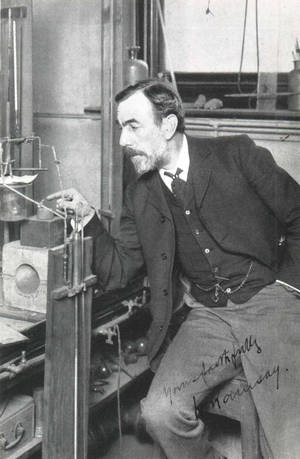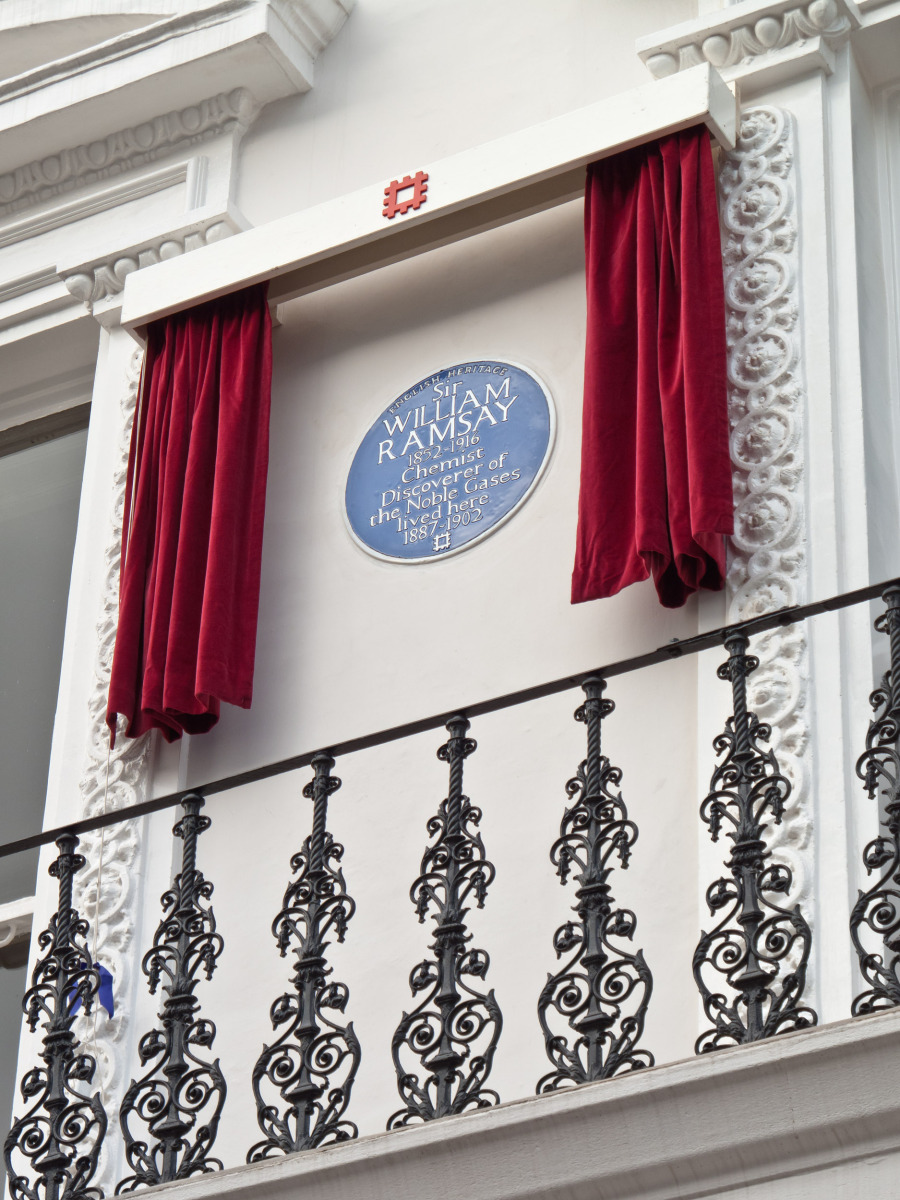Celebrating William Ramsay
Interview with
Chris - In London, Blue Plaques have been placed on buildings across the city for over 140 years to highlight where notable people in history have lived. This week, Meera Senthilingam went along to the unveiling of just such a plaque for a scientist whose work actually changed the field of chemistry...
Meera - I've come along to the chic area of Notting Hill in London and more specifically to number 12 Arundel Gardens, where the home of chemist Sir William Ramsay is being honoured with an English Heritage Blue Plaque. Now as the bagpipes may suggest, Ramsay was Scottish chemist but he was also a Nobel Prize winning one. He was awarded the prize for his work, finding a new group of elements to the periodic table. These are now known as the noble gases. These are a group of odourless, colourless elements that are mainly known for their lack of reactivity. And now, joining me here at number 12, to tell me a bit more about Ramsay's work is Alwyn Davies, Emeritus Professor at the University College London...
 Alwyn - Previously, in 1862, Mendeleev had classified all the elements into a very neat table and Ramsay's gases he found, he prepared, didn't fit into that table. He added a whole new group to it. So, from the fundamental chemical point of view, it was really world shattering.
Alwyn - Previously, in 1862, Mendeleev had classified all the elements into a very neat table and Ramsay's gases he found, he prepared, didn't fit into that table. He added a whole new group to it. So, from the fundamental chemical point of view, it was really world shattering.
Meera - What do we know then about Sir William Ramsay as a chemist at UCL, where he was Chair in Organic Chemistry?
Alwyn - His big characteristic was his devotion to practical work. He was a hands-on man. He wasn't a theoretician. He taught himself glass blowing. He designed and built his own apparatus, but he was prepared to tackle problems which other people would be just too scared to do. He finds two of the rare gases, helium and argon, and he guesses there's something in between. Now he said "here's a supposed inert gas and the whole world to find it in!" He does look in the whole world; He goes to Iceland, he looks in the volcanoes, he goes down to the Pyreneese, he gets meteorites and powders these, and he gets the gases from them. He looks for three years to find something that might not exist. Now that's a thing that most people would be too scared to do.
From the more practical point of view for magnetic resonance image scanning you need liquid helium, one of his gases, to get the strong magnetic field that you need. For doing much chemistry, you need an inert gas to stop the air reacting with chemicals. For that, you use argon. Argon goes into double glazing between the two panes for good insulation. Xenon ions are used for propelling spacecraft. Despite that chemical inertness, or maybe because of it, they do have many uses.
---
Meera - The Blue Plaque Scheme is currently run by English heritage and the historian that researched the case is Dr. Susan Skedd.
Susan - The Blue Plaque Scheme was started in 1866, founded by the Society of Arts. English Heritage has actually only been running it for the last 20 or so years. The scheme was inspired by the need to preserve some of the historic houses around London that were being torn down. So, to begin with, the scheme was about saving historic houses as well as commemorating the homes of notable people. It's not just about the person. It's about their formal home or workplace, and that's why placing a plaque for Ramsay is so important because it was here that he achieved his greatest works really.
Meera - So where does William Ramsay fit into all of this? What makes his home here in Notting Hill appropriate?
Susan - Well, William Ramsay was an outstanding chemist. He won the Nobel Prize for Chemistry, the first Britain to win that Prize, in 1904. He discovered not just one but five of the noble gases and really completed the periodic table of chemical elements.
---
 Meera - As well as Professor Davies, another organiser of today's event is Dr. Andreas Sella, also from University College London. Andreas, another interesting aspect of today's event is the fact that you've also managed to round up a group of cyclists and are yourself kitted out in your cycle gear upon a Brompton bicycle.
Meera - As well as Professor Davies, another organiser of today's event is Dr. Andreas Sella, also from University College London. Andreas, another interesting aspect of today's event is the fact that you've also managed to round up a group of cyclists and are yourself kitted out in your cycle gear upon a Brompton bicycle.
Andrea - Well it seems kind of crazy, what's this got to do with the noble gases? Well in 1887, Ramsay wrote to his sister, breathless with excitement, saying, "I go to college on a bicycle." And you think well, who cares? But if you think about it, the safety bicycle had only been invented a couple of years before. In fact, this is the year before Dunlop invented pneumatic tyres. So he was really on the cusp of new technology and he claimed to be able to cycle from home here in Notting Hill to college in 18 minutes. Now the streets were cobbled. He was using solid state tires. I mean, this would've been an incredible achievement.
Meera - Are you all attempting to race his 18 minutes? So today, the journey from here to UCL involves going through Oxford Circus, so lots of traffic, lots of traffic lights..?
Andrea - I think today really, we're going to be taking the scenic route and actually, we'll be pointing out along the way, other people who lived in the area. There were people like contemporaries, like Sir William Crookes, and so on. We're going to take it quite easy.
Meera - You've really drawn attention to the area of chemistry and chemists like Sir William Ramsay today, as you've managed to bring together scientists, historians, and cyclists all to one place!
Andrea - I think this really tells you about how deeply chemistry permeates our lives. In fact, modern bicycles rely hugely on chemical technology. Whether you're talking about lube, whether you're talking about brake pads, just the alloys, that make up the bicycles themselves. It's all chemistry.
Meera - Well I better let you get off as all the cyclists are waiting for you.
Andrea - Yup! Time to gather together and get the marshals...
Chris - And getting to UCL took them 40 minutes, so a little bit slower than Ramsay's time. That was University College London's Dr. Andrea Sella and before him, Dr. Susan Skedd from English Heritage, and Professor Alwyn Davies, also from University College London.










Comments
Add a comment